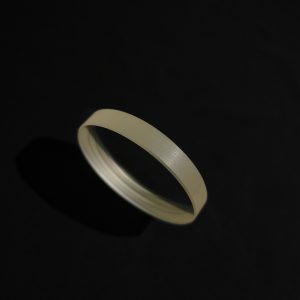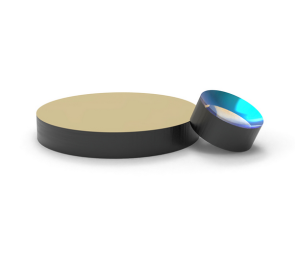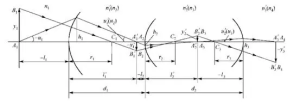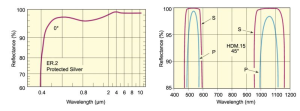Spherical lenses are divided into convex and concave lenses

Convex lens
A convex lens is a lens with a thicker center and thinner edges. Convex lenses have the function of converging light lines, so they are also called “converging lenses” or “positive lenses” (can be used for farsightedness and reading glasses). This type of lens can be divided into:
a. Double convex lens – a lens with two convex faces;
b. Flat convex lens – a lens with one side convex and one side flat;
c. Convex convex lens – a lens with one convex side and one concave side.
The imaging law of convex lenses refers to the inverted real image of an object placed outside the focal point on the other side of the convex lens. There are three types of real images: reduction, equal size, and amplification. The smaller the object distance, the larger the image distance, and the larger the actual image. The object is placed within the focal point and forms an upright magnified virtual image on the same side of the convex lens. The smaller the object distance, the smaller the image distance, and the smaller the virtual image. In optics, the image formed by the convergence of actual light is called a real image, which can be connected by a light screen; On the contrary, it is called a virtual image, which can only be felt by the eyes. Experienced physics teachers often mention a method of distinguishing between real and virtual images: “Real images are inverted, while virtual images are upright.” The so-called “upright” and “inverted” are of course relative to the original object.
Inject parallel light rays (such as sunlight) parallel to the main optical axis (the line connecting the centers of the two spherical surfaces of a convex lens is called the main optical axis of the lens) into the convex lens. After two refractions on both sides of the lens, the light is concentrated at a point on the axis, which is called the focal point of the convex lens (marked as F; English: focus). The convex lens has a real focal point on both sides of the mirror, and in the case of a thin lens, the distance between these two focal points and the center of the lens is roughly equal. The focal length of a convex lens refers to the distance from the focal point to the center of the lens, usually represented by f. The smaller the spherical radius of a convex lens, the shorter the focal length. Convex lenses can be used for magnifying glasses, glasses worn by people with presbyopia and farsightedness, cameras, movie projectors, microscopes, and telescopes. The main axis of a convex lens is the straight line passing through the two spherical centers C1 and C2 of the convex lens. Optical center: The center O point of a convex lens is the optical center of the lens. Focus: Light rays parallel to the main axis pass through a convex lens and converge at a point F on the main optical axis, which is the focus of the convex lens. Focal length: The distance from the focal point F to the optical center O of the convex lens is called focal length, denoted by f. Object distance: The distance from an object to the optical center of a convex lens is called object distance, denoted by u. Image distance: The distance from the image formed by an object passing through a convex lens to the optical center of the convex lens is called image distance, denoted by v.
Formula: 1/u (object distance)+1/v (image distance)=1/f (lens focal length) Regarding the positive or negative sign, the object distance u is always taken as a positive value. The positive and negative values of the image distance v are determined by the real and imaginary values of the image, where v is positive in the real image and negative in the imaginary image. The f of a convex lens is positive, while the f of a concave lens is negative
Concave lens
A concave lens, also known as a negative spherical lens, has a thin center and thick periphery, forming a concave shape, hence it is also called a concave lens. A concave lens has a divergent effect on light. After a parallel light beam deflects through a concave spherical lens, it diverges and becomes a diverging light beam, making it impossible to form a real focal point. Along the opposite extension line of the diverging light beam, it intersects at point F on the same side as the projected light beam, forming a virtual focal point.
The geometric construction of concave lens imaging is the same as that of convex lens imaging. From the top of the object, it also serves as two straight lines: one parallel to the main optical axis, passing through a concave lens and deflecting into divergent light, returning this refracted light in the opposite direction to the main focus; Another optical center point passing through the lens, where these two lines intersect at a point, is the image of the object.
The image formed by a concave lens is always smaller than the upright virtual image of the object, and concave lenses are mainly used for correcting myopia.
Concave lenses have the function of diverging light, so they are also called “diverging lenses” or “negative lenses” (can be used for myopia glasses). This type of lens can be further divided into:
a. Double concave lens – a lens with two concave faces
b. Flat concave lens – a lens with one concave side and one flat side
c. Convex concave lens – a lens with one convex and one concave side
The line connecting the curvature centers on both sides is called the main axis, and the central point O is called the optical center. The light passing through the optical center does not refract no matter where it comes from. A beam of light parallel to the main axis, when refracted on a concave lens, diverges in all directions. The extension line that opposes its divergence direction will all converge at one point F on the same side as the light source, and the refracted light is exactly emitted from point F, which is called the virtual focal point. There is one on each side of the lens. A concave lens is also known as a divergent lens. The focal length of a concave lens refers to the distance from the focal point to the center of the lens. The larger the spherical curvature radius of a lens, the longer its focal length. If it is a thin lens, the focal lengths on both sides are equal.
The image formed by a concave lens is always smaller than that of an object.
Vehicle lens
The optical shape of the lens is the most standard, with clear light and dark cutting lines. By focusing light, the problem of astigmatism is solved. In foreign countries, xenon lamps are standard lenses, which belong to the category of optical mirrors, and we call them “lenses”. Advantages such as low light loss due to adoption. A professional xenon headlight modification master suggests that drivers who have HID headlights but do not have lenses installed. For your own safety and the safety of others, adding lenses is the best choice.
Lens function
1; Because the lens has strong focusing ability, using it to illuminate the road not only makes the road bright but also clear.
2; Due to the small dispersion of light, its light range is longer and clearer than that of ordinary halogen lamps. Therefore, it can enable you to see distant things in the first place, avoiding crossing intersections or missing targets.
3; Compared to traditional headlights, lens style headlights have uniform brightness and strong penetration, so they have strong penetration in rainy or foggy weather. This allows oncoming vehicles to receive lighting information as soon as possible, avoiding accidents.
4; The HID bulb inside the lens has a lifespan of 8 to 10 times that of a regular bulb, thereby reducing the unnecessary trouble of constantly changing the light.
5; The lens xenon lamp does not need to be equipped with any power supply system, as a true HID gas discharge lamp requires a voltage stabilizer with a voltage of 12V, which is then converted to normal voltage to stably and continuously supply the xenon bulb with light. Thus, it can achieve the function of saving electricity.
6; As stated in Article 5, due to the fact that the lens bulb is boosted to 23000V by a stabilizer and is used to stimulate xenon gas to achieve high brightness at the moment of power on, it can maintain brightness for 3 to 4 seconds even when power is off. This can help you prepare for parking in an emergency and avoid disasters. This traditional halogen lamp cannot be achieved.
7; When encountering large trucks or driving lights to notify him, if it still doesn’t work, you can use high beam to notify him.



